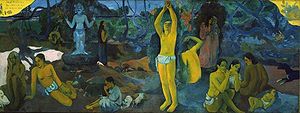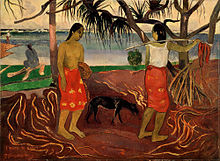His childhood in Peru and travels while in the Navy gave Paul Gauguin a taste for the exotic and primitive cultures. He lived mostly in the South Seas after visiting Martinique in 1890. He had a great may sources of inspiration for his art that ranged from Degas, Manet, Cezanne, Pissarrio, and even Japanese art and the Buddhist art of Java.
In an effort to express anti-naturalistic spirituality, Gauguin evolved his personal symbolist style to a simplification and exaggeration of form, line and color. His experiments with lithography encouraged a use of simple, strong contours and flat planes of color. To create a dull matt surface with unique texture, Gauguin would often use unprimed heavy sackcloth-like fabrics for a substrate.

Gauguin’s paint was usually brushed on, but sometimes he used a palette knife. His usual palette included the cadmium and chrome yellows, yellow ochre, viridian and emerald greens, utramarine and cobalt blues, cobalt violet, red lakes, vermilion and white.
It was common at the time for artists to add wax to their colors to stabilize the paint and reduce the amount of pigment required. Gauguin practiced this and also used the wax to stiffen the paint and make it more matt.


